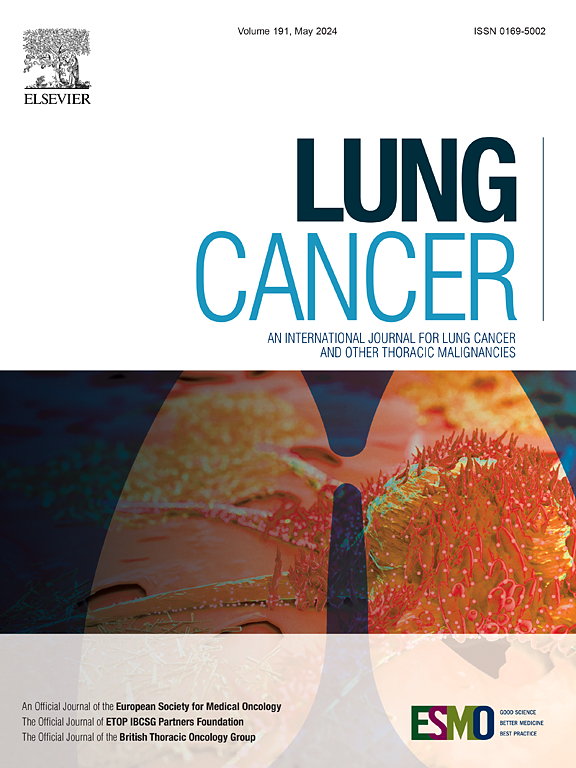Burden and trends in subsequent primary lung cancer incidence by sex in the United States
IF 4.5
2区 医学
Q1 ONCOLOGY
引用次数: 0
Abstract
Introduction
Despite well-documented sex and age differences in lung cancer incidence and trends, it remains unclear whether the patterns differ by tumor sequence. This study compares sex- and age-specific incidence patterns of first primary lung cancers (FPLCs) and subsequent primary lung cancers (SPLCs) in the US.
Methods
Lung and bronchus (hereafter, lung) cancers diagnosed from 2001 to 2021 (ages, 20+ years) were identified from the U.S Cancer Statistics Public Use Database. Age-standardized incidence rates and female-to-male incidence rate ratios (RRs) were calculated for FPLC and SPLC, separately, overall and stratified by age groups (20–49, 50–59, 60–69, 70–79, 80+ years) and diagnosis years (2001–2006, 2007–2011, 2012–2016, 2017–2021).
Results
From 2001 to 2021, there were 3,494,840 FPLC and 1,017,025 SPLC diagnoses. Overall, the incidence rate was 27% lower in women than in men (57.51 versus 78.56 per 100,000) for FPLCs and 32% lower for SPLCs (16.65 versus 24.54 per 100,000). However, the sex gap narrowed at younger ages, with female predominance more pronounced for SPLCs than for FPLCs. Specifically, among ages 20–49, SPLC incidence was 88% higher in women (0.81 vs. 0.43 per 100,000; RR = 1.88, 95% confidence interval [CI] = 1.82–1.94) and, among ages 50–59, it was 26% higher (10.89 vs. 8.63 per 100,000; RR = 1.26, 95% CI = 1.25–1.28), in contrast to comparable or higher rates in males for FPLCs. The female predominance was consistent throughout 2001–2021 for SPLCs (ages, 20–59), whereas it emerged only since 2012–2016 for FPLCs (ages, 20–49).
Conclusion
Sex-specific lung cancer incidence considerably differs by tumor sequence. The female predominance of SPLC among young adults highlights the need for analytical studies to identify risk factors and has important implications for young adult cancer survivorship.
美国按性别划分的原发性肺癌发病率的负担和趋势
尽管有充分证据表明肺癌的发病率和趋势存在性别和年龄差异,但尚不清楚这种模式是否因肿瘤序列而异。本研究比较了美国原发性肺癌(fplc)和继发原发性肺癌(SPLCs)的性别和年龄特异性发病率模式。方法从美国癌症统计公共使用数据库中确定2001年至2021年诊断的肺癌和支气管癌(以下简称肺癌)(年龄20岁以上)。分别计算FPLC和SPLC的年龄标准化发病率和男女发病率比(rr),并按年龄组(20-49岁、50-59岁、60-69岁、70-79岁、80+岁)和诊断年限(2001-2006年、2007-2011年、2012-2016年、2017-2021年)进行总体分层。结果2001 - 2021年,FPLC诊断为34494840例,SPLC诊断为1017025例。总体而言,fplc的女性发病率比男性低27%(57.51比78.56 / 10万),SPLCs的发病率低32%(16.65比24.54 / 10万)。然而,性别差异在年轻时缩小,女性在SPLCs中比在fplc中更明显。具体来说,在20-49岁的人群中,女性的SPLC发病率高出88% (0.81 vs 0.43 / 100,000;RR = 1.88, 95%可信区间[CI] = 1.82-1.94),在50-59岁年龄组中,这一比例高出26%(10.89比8.63 / 10万;RR = 1.26, 95% CI = 1.25-1.28),相比之下,男性的fplc发病率相当或更高。在2001-2021年期间,SPLCs(年龄20-59岁)的女性优势是一致的,而fplc(年龄20-49岁)仅在2012-2016年出现。结论肺癌的发病率因肿瘤序列的不同而有显著差异。年轻成人中女性SPLC的优势突出了分析研究确定危险因素的必要性,并对年轻成人癌症生存具有重要意义。
本文章由计算机程序翻译,如有差异,请以英文原文为准。
求助全文
约1分钟内获得全文
求助全文
来源期刊

Lung Cancer
医学-呼吸系统
CiteScore
9.40
自引率
3.80%
发文量
407
审稿时长
25 days
期刊介绍:
Lung Cancer is an international publication covering the clinical, translational and basic science of malignancies of the lung and chest region.Original research articles, early reports, review articles, editorials and correspondence covering the prevention, epidemiology and etiology, basic biology, pathology, clinical assessment, surgery, chemotherapy, radiotherapy, combined treatment modalities, other treatment modalities and outcomes of lung cancer are welcome.
 求助内容:
求助内容: 应助结果提醒方式:
应助结果提醒方式:


